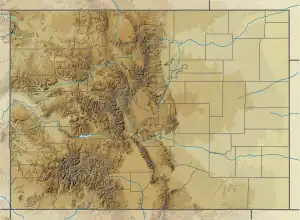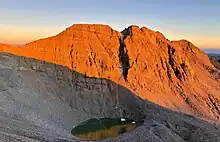| Castle Peak | |
|---|---|
 View from NNE above Montezuma Basin | |
| Highest point | |
| Elevation | 14,279 ft (4352.2 m)[1] NAVD88 |
| Prominence | 2365 ft (721 m)[2] |
| Isolation | 20.9 mi (33.6 km)[2] |
| Listing | |
| Coordinates | 39°00′35″N 106°51′41″W / 39.0097375°N 106.8613598°W[1] |
| Geography | |
 Castle Peak | |
| Location | High point of both Gunnison and Pitkin counties, Colorado, U.S.[2] |
| Parent range | Highest summit of the Elk Mountains[2] |
| Topo map | USGS 7.5' topographic map Hayden Peak, Colorado[3] |
| Climbing | |
| First ascent | 1873 by the Hayden Survey |
| Easiest route | Northeast Ridge: Hike, class 2[4] |
Castle Peak is the ninth highest summit of the Rocky Mountains of North America and the U.S. state of Colorado. The prominent 14,279-foot (4352.2 m) fourteener is the highest summit of the Elk Mountains and the Maroon Bells-Snowmass Wilderness. The peak is located 11.6 miles (18.7 km) northeast by north (bearing 32°) of the Town of Crested Butte, Colorado, United States, on the drainage divide separating Gunnison National Forest and Gunnison County from White River National Forest and Pitkin County. The summit of Castle Peak is the highest point of both counties.[1][2][3][lower-alpha 1]
Mountain
Castle Peak takes its name from its castellated summit.[5] The best climbing months are June, July, August, September through the Montezuma Glacier, a permanent snowfield between Castle and Conundrum Peaks. There are two standard routes for ascent. The Northwest Ridge features a moderate snow climb followed by an easy ridge scramble. It should not be attempted late in the summer when the 200 feet (60 m) of loose dirt and scree meet the climber near the top of the Castle-Conundrum saddle. The Northeast Ridge features an easy snow climb, but slightly harder scrambling and route-finding once on the ridge.
There are two other peaks in Colorado that have the same name: one in Eagle County at 39°46′23″N 106°50′04″W / 39.7730422°N 106.8344844°W,[6] with an elevation 11,280+ feet, (3438+ m);[7] and the other in Mesa County at 39°16′16″N 108°05′40″W / 39.2710898°N 108.0945204°W,[8] with an elevation of 8,140 feet (2,481 m).

Conundrum Peak is a northern subsummit of Castle Peak. It has two closely spaced summits; the northern is higher, with elevation of 14,040+ feet (4279+ m).[9] It is 0.4 miles (0.6 km) north of Castle Peak, and has 200 feet (61 m) of clean topographic prominence. This does not meet the usual 300-foot (91 m) prominence criterion for an officially separate peak; however, it is often climbed in conjunction with Castle Peak.[10]
Climate
| Climate data for Castle Peak 39.0084 N, 106.8615 W, Elevation: 13,491 ft (4,112 m) (1991–2020 normals) | |||||||||||||
|---|---|---|---|---|---|---|---|---|---|---|---|---|---|
| Month | Jan | Feb | Mar | Apr | May | Jun | Jul | Aug | Sep | Oct | Nov | Dec | Year |
| Mean daily maximum °F (°C) | 21.9 (−5.6) |
21.3 (−5.9) |
26.4 (−3.1) |
31.6 (−0.2) |
40.5 (4.7) |
52.5 (11.4) |
57.4 (14.1) |
56.3 (13.5) |
49.8 (9.9) |
39.2 (4.0) |
28.3 (−2.1) |
22.0 (−5.6) |
37.3 (2.9) |
| Daily mean °F (°C) | 10.4 (−12.0) |
9.4 (−12.6) |
14.0 (−10.0) |
18.9 (−7.3) |
27.9 (−2.3) |
38.7 (3.7) |
44.1 (6.7) |
43.1 (6.2) |
36.6 (2.6) |
26.7 (−2.9) |
17.2 (−8.2) |
10.8 (−11.8) |
24.8 (−4.0) |
| Mean daily minimum °F (°C) | −1.2 (−18.4) |
−2.5 (−19.2) |
1.6 (−16.9) |
6.2 (−14.3) |
15.3 (−9.3) |
24.9 (−3.9) |
30.7 (−0.7) |
29.9 (−1.2) |
23.4 (−4.8) |
14.2 (−9.9) |
6.2 (−14.3) |
−0.4 (−18.0) |
12.4 (−10.9) |
| Average precipitation inches (mm) | 5.09 (129) |
5.30 (135) |
5.08 (129) |
5.73 (146) |
3.62 (92) |
1.53 (39) |
2.50 (64) |
2.72 (69) |
2.95 (75) |
3.87 (98) |
4.95 (126) |
4.74 (120) |
48.08 (1,222) |
| Source: PRISM Climate Group[11] | |||||||||||||
See also
Notes
References
- 1 2 3 "CASTLE PK". NGS Data Sheet. National Geodetic Survey, National Oceanic and Atmospheric Administration, United States Department of Commerce. Retrieved January 2, 2016.
- 1 2 3 4 5 "Castle Peak, Colorado". Peakbagger.com. Retrieved January 2, 2016.
- 1 2 "Castle Peak". Geographic Names Information System. United States Geological Survey, United States Department of the Interior. Retrieved November 14, 2014.
- ↑ "Castle Peak Routes". 14ers.com.
- ↑ Gannett, Henry (1905). The Origin of Certain Place Names in the United States. Govt. Print. Off.
- ↑ "Castle Peak". Geographic Names Information System. United States Geological Survey, United States Department of the Interior. Retrieved 2009-01-03.
- ↑ "Castle Peak, Colorado". Peakbagger.com. Retrieved 2009-01-03.
- ↑ "Castle Peak". Geographic Names Information System. United States Geological Survey, United States Department of the Interior. Retrieved 2009-01-03.
- ↑ "North Conundrum Peak, Colorado". Peakbagger.com. Retrieved 2009-01-03.
- ↑ Louis W. Dawson II, Dawson's Guide to Colorado's Fourteeners, Volume 1, Blue Clover Press, 1994, ISBN 0-9628867-1-8
- ↑ "PRISM Climate Group, Oregon State University". PRISM Climate Group, Oregon State University. Retrieved October 9, 2023.
To find the table data on the PRISM website, start by clicking Coordinates (under Location); copy Latitude and Longitude figures from top of table; click Zoom to location; click Precipitation, Minimum temp, Mean temp, Maximum temp; click 30-year normals, 1991-2020; click 800m; click Retrieve Time Series button.
External links
- "Castle Peak". 14ers.com.
- "Conundrum Peak". 14ers.com.
- "Castle Peak". SummitPost.org.
- "Conundrum Peak". SummitPost.org.
- "Castle Peak / Conundrum Peak". Colorado Fourteeners. Archived from the original on 2008-03-29. Retrieved 2011-05-09.
- "Castle Peak". Peakware.com. Archived from the original on 2016-03-04. Retrieved 2011-05-09.